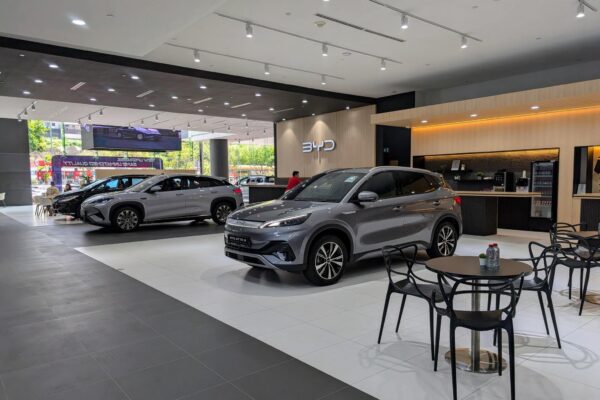
I recently bought a BYD M6. It’s a 7-seater electric vehicle. I’ll write a review on the car in a later post. For now, I just want to write about the company itself, BYD. No, this blog isn’t turning into a car blog, but technically since an electric car is like a tech gadget, it pretty much fits into the usual things I write about.
Unless you’ve been living under a rock, you must have heard about BYD by now. I know, Tesla may be the household name when it comes to electric vehicles, but if you didn’t know, BYD has not only established itself as one of the largest car manufacturers in the world but also overtaken Tesla in multiple ways.
For example, in 2024, BYD beat Telsa in both vehicle unit sales as well as revenue. BYD shipped 4.3M NEVs (New Energy Vehicles), vastly outperforming Tesla’s 1.79M EVs. The term NEV includes both pure battery Electric Vehicle and Plug-in Hybrid Electric Vehicle (PHEV). BYD’s 4.3M NEVs include 1.76M EV. If you’re thinking that BYD hasn’t overthrown Tesla in EV sales, well, they have in the 1st quarter of 2025, where BYD shipped almost 24% more EVs than Tesla. Most impressively, BYD has achieved these milestones while not being allowed to sell in the United States, whereas Telsa not only sells in China but also has a large manufacturing facility in Shanghai Pudong.
BYD entered the Singapore consumer car market in 2022, one year after Tesla. Today, BYD sales represent 20% of all new car registrations, and 50% of all new EV registrations. BYD registered 3827 new cars from Jan to May this year, compared to 947 from Tesla. Right now, BYD has become the most popular brand of new cars, even overtaking perennial favourite Toyota.
I did not think much about Chinese car manufacturers even as recently as three years ago. Chery, a Chinese brand that debut in Singapore in 2006, didn’t leave a good impression. Their QQ car was cheap and had questionable quality. The vibe about Chinese cars then was a mix of skepticism and mockery.
This has since turned around completely. Chinese car brands have come a long way to become recognised as legit competition alongside other established brands from Japan, Europe, and United States. Perhaps not everyone agrees, but clearly the general perception of Chinese cars has changed for the better. Afterall, several notable European brands are now actually owned by Chinese, such as:
- Volvo (owned by Geely)
- Polestar (owned by Geely)
- Lotus (majority stake by Geely)
- MG / Morris Garages (owned by SAIC Motor Corporation)
BYD, oddly enough, begun as a battery manufacturer in 1995. They old batteries to major smartphone manufacturers, including Nokia, Motorola, Sony, and Samsung. They entered the car manufacturing business in 2003 by acquiring an existing car maker, designed their own conventional ICE (internal combustion engine) car in 2005, and begun making PHEV and EV in 2008.
BYD’s secret weapon is their insane vertical integration, which gives them control over their entire supply chain. From battery chemistry (Blade Battery, LFP) to electric drivetrains, chassis design, and software (like the “super E-platform”), BYD cuts costs, reduces dependencies, and better controls quality.
Their Blade Battery is particularly fascinating. To just say it is safer is an understatement. BYD famously demonstrated how their battery can be fully punctured by a nail without even smoking, whereas conventional lithium ion batteries would have erupted into a fireball. The newest Blade Battery supports ultra-fast 1,000 V charging, adding up to 400 km range in just 5 mins.
Like many of their Chinese competitors, BYD has come of age. They are no longer just a fast follower or a low-cost alternative, but a legitimate innovator in its own right. Today, BYD stands at the forefront of the global EV movement, pushing the boundaries of innovation with its own proprietary technologies.
BYD’s value proposition in Singapore is pretty enticing. The offer 6-years vehicle warranty, 10-years warranty on the main high-voltage battery, and 10-years of free servicing. This not only gives some peace of mind, but also potentially some savings in routine maintenance costs. They now have three service centres, which hopefully will address some earlier complaints about insufficient capacity (with particularly long waiting times to get a servicing appointment).
Whichever style of car you want, be it SUV or MPV, sedan or hatch, BYD has something for everyone. They also have the Denza luxury MPV if you’re looking for something more premium.
To close off, let me answer the question of why the BYD M6 for me. It’s fairly simple. There aren’t many 7-seater options at $180K or below. This is across all mainstream car brands and across all ICE/hybrid/EV car categories. Even if I stretch to $200K, the choices are still limited. I know that for EVs the simple on-the-road price may not correctly reflect the cost coming from EV incentives, but all things considered, the BYD M6 still offers a compelling value that is hard to match. Although I did not work out the math for other BYD models, I think likely the numbers will still favour BYD over other brands.
